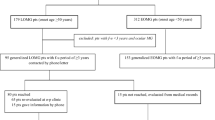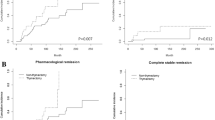Abstract
Thymectomy is an effective treatment for myasthenia gravis (MG). However, there is limited data on its effectiveness in non-thymomatous late-onset MG (LOMG). The aim of this study was to analyze the effects of thymectomy in LOMG. We retrospectively reviewed the 2-year post-thymectomy prognosis in 39 consecutive patients with non-thymomatous, anti-acetylcholine receptor antibody positive, and generalized LOMG (age at onset ≥50 years). The MG foundation of America (MGFA) classification, MGFA post-intervention status, dosage of prednisolone and pyridostigmine, and anti-acetylcholine receptor antibody titers were evaluated. Among the 39 LOMG patients, thymic hyperplasia was seen in 5 (12.8 %). MGFA classification and prednisolone dosage before thymectomy were similar between the LOMG with thymic hyperplasia group (n = 5) and the LOMG with involuted thymus group (n = 34). Two years after thymectomy, the LOMG patients with thymic hyperplasia showed higher proportion of remission (60 vs. 26 %) and received lower prednisolone dosage compared to patients with involuted thymus (0.8 vs. 4.0 mg/day). Notably, the proportion of patients with minimal manifestation or better status with receiving ≤5 mg/day prednisolone was much higher in the thymic hyperplasia group than in the involuted thymus group (100 vs. 62 %). In conclusion, thymectomy could have beneficial effects in generalized LOMG, particularly in patients with thymic hyperplasia.



Similar content being viewed by others
References
Meriggioli MN, Sanders DB (2009) Autoimmune myasthenia gravis: emerging clinical and biological heterogeneity. Lancet Neurol 8:475–490
Leite MI, Jones M, Ströbel P et al (2007) Myasthenia gravis thymus: complement vulnerability of epithelial and myoid cells, complement attack on them, and correlations with autoantibody status. Am J Pathol 171:893–905
Schluep M, Willcox N, Vincent A, Dhoot GK, Newsom-Davis J (1987) Acetylcholine receptors in human thymic myoid cells in situ: an immunohistological study. Ann Neurol 22:212–222
Tomulescu V, Sgarbura O, Stanescu C et al (2011) Ten-year results of thoracoscopic unilateral extended thymectomy performed in nonthymomatous myasthenia gravis. Ann Surg 254:761–766
Pompeo E, Tacconi F, Massa R, Mineo D, Nahmias S, Mineo TC (2009) Long-term outcome of thoracoscopic extended thymectomy for nonthymomatous myasthenia gravis. Eur J Cardiothorac Surg 36:164–169
Ströbel P, Moritz R, Leite MI et al (2008) The ageing and myasthenic thymus: a morphometric study validating a standard procedure in the histological workup of thymic specimens. J Neuroimmunol 201–202:64–73
Murai H, Masuda M, Utsugisawa K et al (2014) Clinical features and treatment status of adult myasthenia gravis in Japan. Clin Exp Neuroimmunol 5:84–91
Jaretzki A, Barohn RJ, Ernstoff RM et al (2000) Myasthenia gravis: recommendations for clinical research standards. Task Force of the Medical Scientific Advisory Board of the Myasthenia Gravis Foundation of America. Neurology 55:16–23
Utsugisawa K, Suzuki S, Nagane Y et al (2014) Health-related quality-of-life and treatment targets in myasthenia gravis. Muscle Nerve 50:493–500
Kawaguchi N, Kuwabara S, Nemoto Y et al (2007) Effects of thymectomy on late-onset myasthenia gravis without thymoma. Clin Neurol Neurosurg 109:858–861
Conflicts of interest
The authors declare that there are no conflicts of interest.
Ethical standard statement
The Ethics Committee of Chiba University School of Medicine, Chiba, Japan, approved the study and informed consent was obtained from all the study subjects.
Author information
Authors and Affiliations
Corresponding author
Rights and permissions
About this article
Cite this article
Uzawa, A., Kawaguchi, N., Kanai, T. et al. Two-year outcome of thymectomy in non-thymomatous late-onset myasthenia gravis. J Neurol 262, 1019–1023 (2015). https://doi.org/10.1007/s00415-015-7673-z
Received:
Revised:
Accepted:
Published:
Issue Date:
DOI: https://doi.org/10.1007/s00415-015-7673-z




